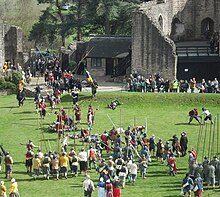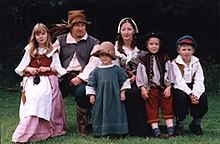The Sealed Knot (reenactment)
This article needs additional citations for verification. (February 2011) |

The Sealed Knot is a British historical association and charity, with many members from outside the United Kingdom, dedicated to costumed reenactment of battles and events surrounding the English Civil War.
About
The Sealed Knot takes its name from the original
History
The Sealed Knot was founded by Brigadier
With its large membership and high profile the Sealed Knot is the largest and best known of all the many re-enactment and historical groups and societies in the UK.[1][2] Its official journal, Orders of the Day, is published every three months and sent to all members. It contains information about forthcoming events.

The Sealed Knot comprises a number of regiments split into Parliamentarian, Royalist and Scots armies. The group was responsible for the first commemoration in 1971 of the Battle of Nantwich (which originally took place in 1644) and in 1973 the Sealed Knot staged the first re-enactment of the battle, which has now become an annual event at the end of January and is known as "Holly Holy Day".[3]
Regiments

The Sealed Knot is made up of smaller groups, each run semi-autonomously, and known to their members as "regiments", their names and identities closely linked to regiments that took part in the English Civil War. Each of these regiments falls under one of the armies of the society: the Royalist Army, the Army of Parliament and the Army of Ireland and Scotland. The other sections are those who deal with pyrotechnics, the medical service, the living history group and Friends of the Knot. [4] There are two different types of regiment – "foote" are infantry with pikemen and musketeers, while "horse" are regiments of cavalry. The Thomas Rainsborough Company took part in the opening ceremony for a plaque commemorating the burial of Thomas Rainsborough in Wapping on 12 May 2013.
Parliament The Army of Parliament is divided into four Brigades, each made up of regiments, bands and dragoones. In addition there are three units that report directly to the Lord General: Sir William Waller’s Lifeguard of Horse, Oakey’s Dragoons, and the trayne of Artillery. The Lord General heads the Army. He is assisted by his Staff, who range from the Chief of Staff to humble runners. The following list shows the regiments in each brigade:
CITTIE OF LONDON BRIGADE: The Blew Regiment of the Cittie of London Trayned Bandes,
The Earl of Essex Hys Regiment of Foote,
Colonel Roberts Hammond's Regiment of Foote,
Colonel Samuel Jones' Regiment of Foote,
Tower Hamlets Trayned Bandes,
Sir Arthur Heselrigge's Independent company,
OLIVER CROMWELL'S: Colonel John Birch's Regiment of Foote,
Sergeant Major General Phillip Skippon's Regiment of Foote,
Colonel John Pickering’s Regiment of Foote,
Lieutenant Colonel John Lilburne's Regiment of Foote,
SIR THOMAS FAIRFAX'S: Sir John Gell’s Regiment of Foote,
Colonel John Hutchinson's Regiment of Foote,
Earl of Manchester's Regiment of Foote,
Lord Saye & Sele's Regiment of Foote,
SIR WILLIAM WALLER'S: Colonel Thomas Ballard’s Regiment of Foote,
Sergeant Major General James Carr’s Regiment of Foote,
Lord John Robarte’s Regiment of Foote,
Earl of Stamford's Regiment of Foote
Parody
The Sealed Knot is parodied as "The Peeled Nuts" in the
See also
- List of historical reenactment groups
- English Civil War reenactment
- English Civil War Society
Notes
- ^ The Sealed Knot Official Website, http://www.thesealedknot.org.uk/
- ISBN 978-0-415-39945-6.
- ^ The Cat (2011) "The Battle of Nantwich – Holly holy day", http://thecatradio.blogspot.com/2011/01/holly-holy-day-in-nantwich-cheshire-is.html
- ^ "Royalist Army | The Sealed Knot". www.thesealedknot.org.uk. Archived from the original on 2010-08-22.
Records of the Sealed Knot; 1968 - 2014 https://mss-cat.nottingham.ac.uk/Calmview/Record.aspx?src=CalmView.Catalog&id=SK
